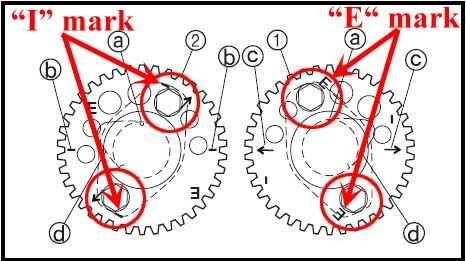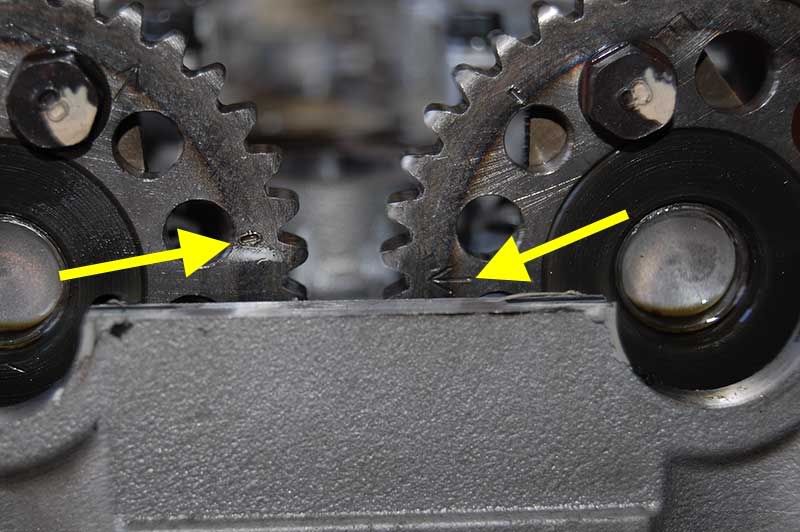QUOTE (bhkfjr @ Oct 23 2009, 02:38 AM) <{POST_SNAPBACK}>
As an additional note:
I had new exhaust and intake sprockets installed (along with chain and tensioner) during the last valve check. Could these be put on somewhat mis-aligned or is that very not likely?
I having the dealer re-check their work tomorrow and want to be able to have ideas on what to look for in addition to the timing marks
ANY suggestions are welcome and appreciated!
I had new exhaust and intake sprockets installed (along with chain and tensioner) during the last valve check. Could these be put on somewhat mis-aligned or is that very not likely?
I having the dealer re-check their work tomorrow and want to be able to have ideas on what to look for in addition to the timing marks
ANY suggestions are welcome and appreciated!
Yes, indeed, the sprockets can be mounted incorrectly.
First, you must remember that both cams and sprockets are identical. Same part numbers for both intake and exhaust cams and sprockets. What makes them work is totally dependent on correct sprocket alignment when installed on the cams. Take a look at this picture:

On the intake cam (left side of picture) the sprocket MUST be bolted on to the cam so the sprocket bolts (circled) are bolted next to the "I" symbols on the sprockets. If they're bolted 180 degrees off, it doesn't matter, as long as the bolts that hold the sprocket on the cam are bolted through the "I" hole in the sprocket.
The only difference for the exhaust cam sproket is the bolt must go through the hole in the sprocket (circled) marked "E".
The orientation of the sprockets on the cams determines which cam is an intake cam and which is an exhaust cam.
Once the sprockets are installed correctly, depending on their intake or exhaust designation, then having the cams "in time" with the crankshaft is next AND most important.

With the "T" mark on the timing rotor at the right-side end of the crankshaft lined up with the mark on the block (the spot where the crankcase splits) then the cams must be aligned where their timing marks align PERFECTLY with the top surface of the cylinder head.

Notice in the above picture, you can plainly see one of the bolts holding the sprocket on the (left) intake cam and the bolt is right next to the "I" mark, which is just above and to the left of the bolt head. On the (right) exhaust cam, the bolt is right next to the"E" mark, just above and to the right.
The cams are "in time" with the crankshaft when:
1 - The "T" mark on the crankshaft rotor is aligned perfectly with the split in the crankcase (picture #2)
2 - The "— —"marks on the intake sprocket are perfectly parallel with the cylinder head (picture #3)
3 - The "<— —>" marks on the exhaust sprocket are perfectly parallel with the cylinder head (picture #3), AND
4 - The holes in the intake and exhaust cams line up with the casting marks on the cam holddown bracket (picture below, #4)

BTW, WHEN the holes line up with the casting marks, the cam lobes on cylinder #1 should be pointing to 10 o'clock and 2 o'clock, as viewed from the sprocket ends of the cams.
Here's the problem with timing the cams.....it's VERY easy to get one cam a tooth out of time with the other cam. Even with my motor out of the bike, with nothing in the way, and taking the UTMOST care installing a new camchain and tensioner on my motor, here's what happened the first time I locked everything down:

Even taking care and using surgical precision, I timed the intake cam one tooth off. Had to release the tensioner, pull the chain off the intake cam and turn the cam one tooth clockwise to get it back in time.
Doing this job with the motor in the frame is difficult and triple checking all the facets of 1 thru 4 I detailed above is critical for nominal operation AND to prevent valve damage. A tech "on the clock" might get sloppy, lazy, or both, and not have things just so.
Hope this helps.
'Howie


